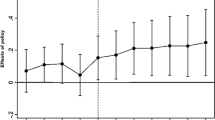Abstract
The paper considers the dynamics of the socioeconomic development of 75 cities, administrative centers of Russian regions. The main objective of the study is to test the authors’ methodology, which makes it possible to determine and classify the trajectories of change in the relative position of a city in the investigated set in each year of the period. Unlike the common analysis scheme, when situations at the beginning and end of the period are compared, the authors investigate changes over 11 years on an annual basis, i.e., the trajectory of change in the relative position of an object in the selected set. The study and comparison of the trajectories makes it possible to (a) see inflection points, i.e., the years in which the development of a city was relatively accelerated or decelerated in order to further reveal the factors of the change in trajectory and (b) to suggest a basis for grouping cities by trajectory type. The methodology calculates the city development dynamics index by integrating the nine indicators and constructing a rank vector. In addition, the characteristics of a sampling, such as the minimum and maximum values and variation coefficients, are calculated for each of the nine primary indicators for each year. Cities are grouped by the rank vectors that describe the trajectory of the dynamics. Groups of cities that are steadily growing faster than others, stably lagging behind, and with changing trajectories are identified. Hypotheses explaining the acceleration or deceleration of the development of individual cities are put forward. No significant relationship between acceleration of development and development of official strategies has been established.
Similar content being viewed by others
References
Animitsa, E.G., The largest cities of Russia in the context of global urbanization processes, Ars Administrandi, 2013, no.1. http://cyberleninka.ru/article/n/krupneyshie-goroda-rossii-v-kontekste-globalnyh-urbanizatsionnyh-protsessov. Accessed May 5, 2017.
Golubchikov, O.Yu. and Makhrova, A.G., Factors of unequal development of Russian cities, Vestn. Mosk. Univ., Ser. 5: Geogr., 2013, no. 2, pp. 56–60.
Zhikharevich, B.S. and Pribyshin, T.K., Diffusion of practice of strategic planning in Russian cities and towns in 1997–2013, Reg. Res. Russ., 2014, vol. 4, no. 4, pp. 279–285.
Zhikharevich, B.S. and Rusetskaya, O.V., Kolebaniya v sotsial’no-ekonimicheskom razvitii krupnykh gorodov Rossii: metodika i rezul’taty rascheta “vektora dinamiki” (Fluctuations of the Socioconomic Development of Large Cities in Russia: Method and Results of Calculation of “Dynamics Vector”), St. Petersburg: Ross. Geogr. O-vo, 2014, vol. 146, no. 4, pp. 1–12.
Zemtsov, S.P., Baburin, V.L., and Barinova, V.A., How to measure the immeasurable? Assessment of the innovative potential of Russian regions, Kreat. Ekon., 2015, vol. 9, no. 1 (97), pp. 35–52.
Zubarevich, N.V., Major Russian cities: leaders and outsiders, Demoscope Weekly, 2013, no. 551−552, p. 1.
Zubarevich, N.V., Regions and cities of Russia: scenarios-2020, Pro Contra, 2011, vol. 15, no. 1-2, pp. 57–71.
Zubarevich, N.V. and Safronov, S.G., Disparity in socioeconomic development of regions and cities of Russia in the 2000s: growth or decline? Obshch. Nauki Sovrem., 2013, no. 6, pp. 15–26.
Zubarevich, N.V., Socioeconomic development of large cities in Russia: capabilities for measurements and factors of differentiation, in Modernizatsionno-innovatsionnye protsessy v sotsial’no-ekonomicheskom razvitii regionov i gorodov (Modernization-Innovative Processes in Socioconomic Development of Regions and Cities), Yekaterinburg: Ural. Gos. Ekon. Univ., 2013, book 1, pp. 298–312.
Zubarevich, N.V., Country of cities: theory and practice of Russian urbanization, in Stimuly. Paradoksy. Provaly. Gorod glazami ekonomistov (Incentives. Paradoxes. Failures. City through the Eyes of Economists), Auzan, V., Ed., Moscow: Strelka Press, 2015, pp. 20–34.
Lappo, G.M., Goroda Rossii: Vzglyad geografa (Russian Cities: View of a Geographer), Moscow: Novyi Khronograf, 2012.
Leksin, V.N., Cities of power: administrative centers of Russia, Mir Ross., 2009, no. 1, pp. 3–33.
Leksin, V.N. and Porfir’ev, B.N., Megapolises and Megapolisness phenomenon in Russia, Reg.: Ekon. Sotsiol., 2017, no. 1 (93), pp. 42–77.
Leksin, V.N. and Shvetsov, A.N., Local self-governance and municipal development as objects of system analysis and regulation. Researches and projects of the Institute of System Analysis of the Russian Academy of Sciences, Munits. Imushchestvo: Ekon., Pravo, Uprav., 2017, no. 2, pp. 28–32.
Lyubovnyi, V.Ya., Goroda Rossii: al’ternativy razvitiya i upravleniya (Russia’s Cities: Alternatives of Development and Governance), Moscow: Ekon-Inform, 2013.
Minashkin, V.G., Shmoilova, R.A., Sadovnikova, N.A., Moiseikina, L.G., and Rybakova, E.S., Teoriya statistiki (The Theory of Statistics), Moscow: Mosk. Fin.-Prom. Akad., 2004.
Pertsik, E.N., Problems of development of urban agglomerations, Academia. Arkh. Stroit., 2009, no. 2, pp. 63–69.
Untura, G.A., Composite indices as tools for analysis of innovative development of federal subjects, in Formirovanie innovatsionnoi ekonomiki: kontseptual’nye osnovy, metody i modeli (Development of Innovative Economics: Conceptual Basis, Methods, and Models), Suslov, V.I. and Kravchenko, N.A., Eds., Novosibirsk: Avtograf, 2014, ch. 3.1, pp. 142–169.
Giffinger, R., Kramar, H., and Haindl, G., The role of rankings in growing city competition, Urban Res. Pract., 2010, vol. 3, no. 3, pp. 3–15.
Alp, N., Socioeconomic development index ranking calculations of cities with fuzzy clustering method: case of Turkey, Theor. Appl. Econ., 2015, vol. 22, no. 1 (602), pp. 215–226.
Rovan, J. and Sambt, J., Socio-economic differences among Slovenian municipalities: a cluster analysis approach, Metodol. Zvezki, 2003, vol. 19, pp. 265–278.
Rusetskaya, O.V., Grouping cities based of their socioeconomic indicators, Appl. Electron. Notes Discrete Math., 2017, vol. 58, pp. 223–230.
Zhikharevich, B.S., Rusetskay, O.V., and Mladenović, N., Clustering cities based on their development dynamics and variable neighborhood search, Appl. Electron. Notes Discrete Math., 2015, vol. 47, pp. 213–220.
Zhikharevich, B.S. and Rusetskaya, O.V., Fluctuations in the socioeconomic development of Russian cities: methodology and results of the calculation the rank vector of dynamics, Appl. Reg. Res. Russ., 2015, vol. 5, pp. 37–44.
Author information
Authors and Affiliations
Corresponding author
Additional information
Original Russian Text © B.S. Zhikharevich, O.V. Rusetskaya, 2017, published in Izvestiya Russkogo Geograficheskogo Obshchestva, 2017, Vol. 149, No. 6, pp. 75–95.
Rights and permissions
About this article
Cite this article
Zhikharevich, B.S., Rusetskaya, O.V. Fluctuations in the Relative Dynamics of Development of Russia’s Regional Centers in 2003–2013. Reg. Res. Russ. 8, 34–45 (2018). https://doi.org/10.1134/S2079970518010100
Received:
Published:
Issue Date:
DOI: https://doi.org/10.1134/S2079970518010100




